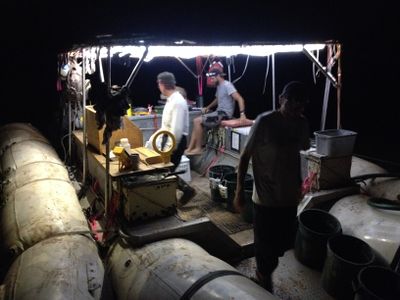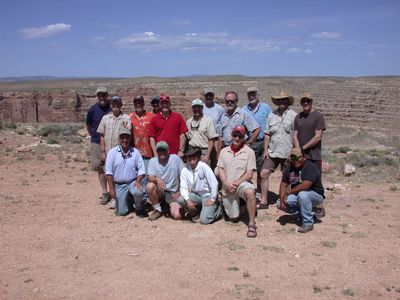|
References Cited/High Priority Reading List for Panel Review:
Avery, L.A., Korman, J., and Persons, W.R., 2015, Effects of increased discharge on spawning
and age-0 recruitment of rainbow trout in the Colorado River at Lees Ferry, Arizona: North
American Journal of Fisheries Management, v. 34, no. 4, p. 671-680,
http://dx.doi.org/10.1080/02755947.2015.1040560.
Bureau of Reclamation, and U.S. Geological Survey, 2014, Glen Canyon Dam Adaptive
Management Program triennial budget and work plan—Fiscal years 2015-2017: Bureau of
Reclamation, Upper Colorado Regional Office and U.S. Geological Survey, Grand Canyon
Monitoring and Research Center, prepared in cooperation with the Glen Canyon Dam Adaptive
Management Program, 469 p. (Projects 5-10 only, p. 199-378; PDF with only project summaries
included in full reference list).
Dodrill, M.J., Yackulic, C.B., Kennedy, T.A., and Hayes, J.W., 2016, Prey size and availability
limits maximum size of rainbow trout in a large tailwater—Insights from a drift-foraging
bioenergetics model: Canadian Journal of Fisheries and Aquatic Sciences, v. 73, no. 5, p. 759-
772, http://dx.doi.org/10.1139/cjfas-2015-0268.
Dongoske, K.E., Jackson-Kelly, L., and Bulletts, C., 2010, Confluence of values—The role of
science and Native Americans in the Glen Canyon Dam Adaptive Management Program, in
Melis, T.S., Hamill, J.F., Bennett, G.E., Coggins, L.G., Jr., Grams, P.E., Kennedy, T.A., Kubly,
D.M., and Ralston, B.E., eds., Proceedings of the Colorado River Basin Science and Resource
Management Symposium, November 18-20, 2008, Scottsdale, Arizona: U.S. Geological Survey
Scientific Investigations Report 2010-5135, 133-140 p., http://pubs.usgs.gov/sir/2010/5135/.
Jordan, J., and Hamill, J.F., 2015, Lees Ferry recreational trout fishery management
recommendations--The voice of Lees Ferry recreational anglers, guides, and businesses: Trout
Unlimited, International Federation of Fly Fishers, Theodore Roosevelt Conservation
Partnership, and Wildlife for Tomorrow, 13 p.,
http://www.trcp.org/images/uploads/wygwam/Lees-Ferry-Recommendations-final-8-6-5.pdf.
Kennedy, T.A., Muehlbauer, J.D., Yackulic, C.B., Lytle, D.A., Miller, S.W., Dibble, K.L.,
Kortenhoeven, E.W., Metcalfe, A.N., and Baxter, C.V., 2016, Flow management for hydropower
extirpates aquatic insects, undermining river food webs: BioScience, v. 66, no. 7, p. 561-575,
http://dx.doi.org/10.1093/biosci/biw059.
Korman, J., Martell, S.J.D., Walters, C.J., Makinster, A.S., Coggins, L.G., Yard, M.D., and
Persons, W.R., 2012, Estimating recruitment dynamics and movement of rainbow trout
(Oncorhynchus mykiss) in the Colorado River in Grand Canyon using an integrated assessment
model: Canadian Journal of Fisheries and Aquatic Sciences, v. 69, no. 11, p. 1827-1849,
http://dx.doi.org/10.1139/F2012-097.
Korman, J., Yard, M.D., and Yackulic, C.B., 2016, Factors controlling the abundance of rainbow
trout in the Colorado River in Grand Canyon in a reach utilized by endangered humpback chub:
Canadian Journal of Fisheries and Aquatic Sciences, v. 73, no. 1, p. 105-124,
http://dx.doi.org/10.1139/cjfas-2015-0101.
National Park Service, 2013, Comprehensive fisheries management plan, Grand Canyon
National Park, Glen Canyon National Recreation Area Finding of No Significant Impact
(FONSI): Coconino County, Ariz., Department of the Interior, National Park Service, Grand
Canyon National Park, 46 p. (p. 1-17 only),
https://parkplanning.nps.gov/document.cfm?parkID=65&projectID=35150&documentID=56565
Persons, W.R., Van Haverbeke, D.R., and Dodrill, M.J., 2016 (in review), Colorado River fish
monitoring in Grand Canyon, Arizona—2002-2014 humpback chub aggregations: U.S.
Geological Survey report XXXX. [Available upon request by contacting Scott Vanderkooi,
[email protected]].
Rogers, S., 2015, Fisheries management plan Colorado River-Lees Ferry 2015-2025: Arizona
Game and Fish Department, Sport Fish Restoration, Region II Fish Program, 15 p.,
http://www.usbr.gov/uc/rm/amp/twg/mtgs/15oct20/pdfs/Attach_06c.pdf.
Rogowski, D.L., Osterhoudt, R.J., Winters, L.K., and Wolters, P.N., 2016, Colorado River fish
monitoring in Grand Canyon, Arizona—2015 annual report: Flagstaff, Arizona Game and Fish
Department, submitted to U.S. Geological Survey, Grand Canyon Monitoring and Research
Center, cooperative agreement #G13AC00086.
Stone, D.M., and Gorman, O.T., 2006, Ontogenesis of endangered humpback chub (Gila cypha)
in the Little Colorado River, Arizona: American Midland Naturalist, v. 155, no. 1, p. 123-135,
http://dx.doi.org/10.1674/0003-0031(2006)155[0123:OOEHCG]2.0.CO;2.
Van Haverbeke, D.R., Stone, D.M., Coggins, L.G., and Pillow, M.J., 2013, Long-term
monitoring of an endangered desert fish and factors influencing population dynamics: Journal of
Fish and Wildlife Management, v. 4, no. 1, p. 163-177, http://dx.doi.org/10.3996/082012-
JFWM-071.
Ward, D.L., and Morton-Starner, R., 2015, Effects of water temperature and fish size on
predation vulnerability of juvenile humpback chub to rainbow trout and brown trout:
Transactions of the American Fisheries Society, v. 144, no. 6, p. 1184-1191,
http://dx.doi.org/10.1080/00028487.2015.1077160.
Winters, L.K., Rogowski, D.L., and Wolters, P.N., 2016, Status of the Lees Ferry rainbow trout
fishery—2015 annual report: Flagstaff, Arizona Game and Fish Department, Research Branch,
Colorado River Research Office, submitted to U.S. Geological Survey, Grand Canyon
Monitoring and Research Center, cooperative agreement #G10AC00147, 47 p.
Yackulic, C.B., Yard, M.D., Korman, J., and Van Haverbeke, D.R., 2014, A quantitative life
history of endangered humpback chub that spawn in the Little Colorado River—Variation in
movement, growth, and survival: Ecology and Evolution, v. 4, no. 7, p. 1006-1018,
http://dx.doi.org/10.1002/ece3.990.
Yard, M.D., Coggins, L.G., Baxter, C.V., Bennett, G.E., and Korman, J., 2011, Trout piscivory
in the Colorado River, Grand Canyon—Effects of turbidity, temperature, and fish prey
availability: Transactions of the American Fisheries Society, v. 140, no. 2, p. 471-486,
http://dx.doi.org/10.1080/00028487.2011.572011.
Zuni Tribe, 2010, Cover letter from Governor Norman J. Cooeyate and Tribal Council
Resolution regarding the Grand Canyon as a register-eligible Zuni TCP and mechanical removal:
Zuni Indian Reservation, New Mex., Zuni Tribe, Resolution #M70-2010-C086, submitted to
Bureau of Reclamation and Secretary of the Interior Kenneth Salazar, 6 p.
|

